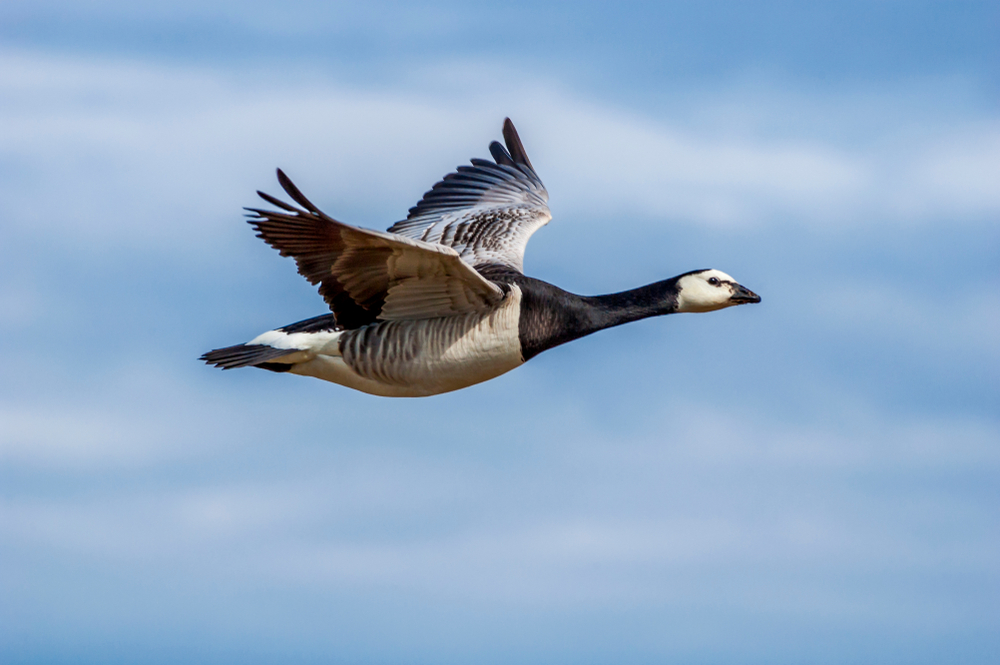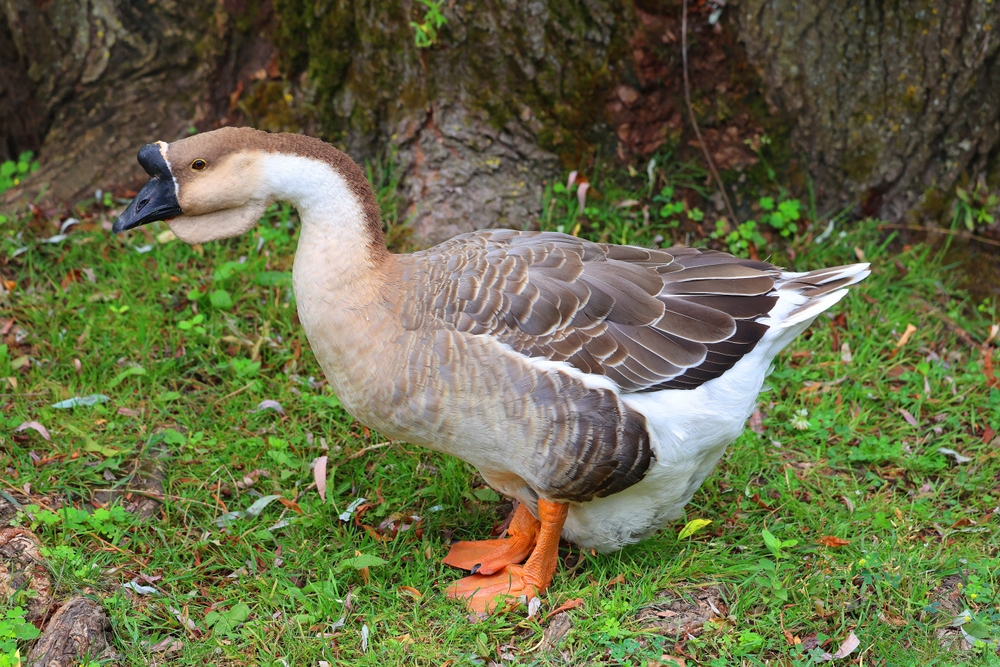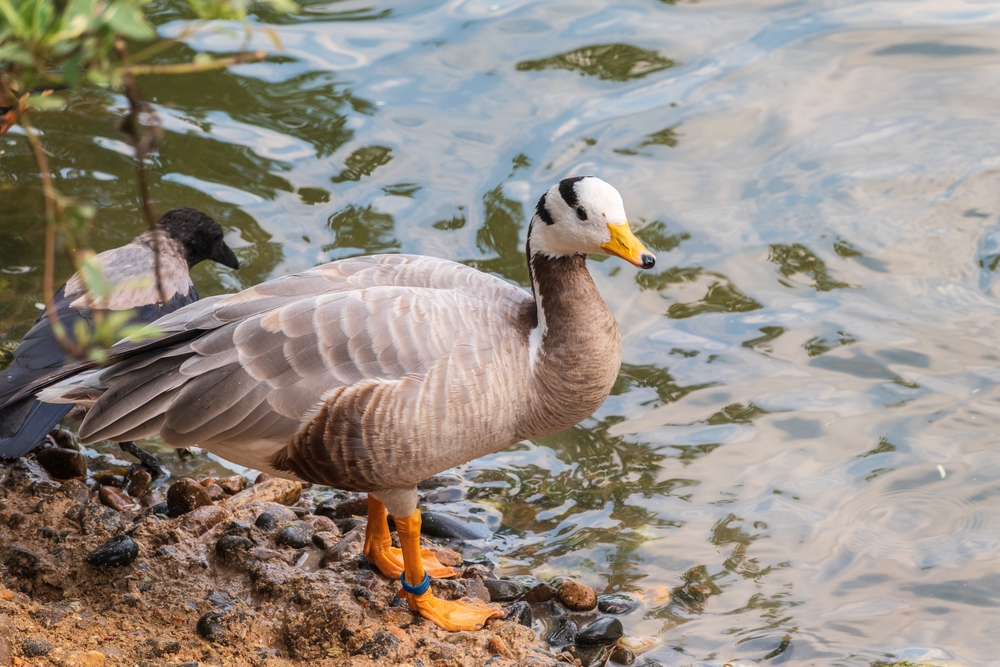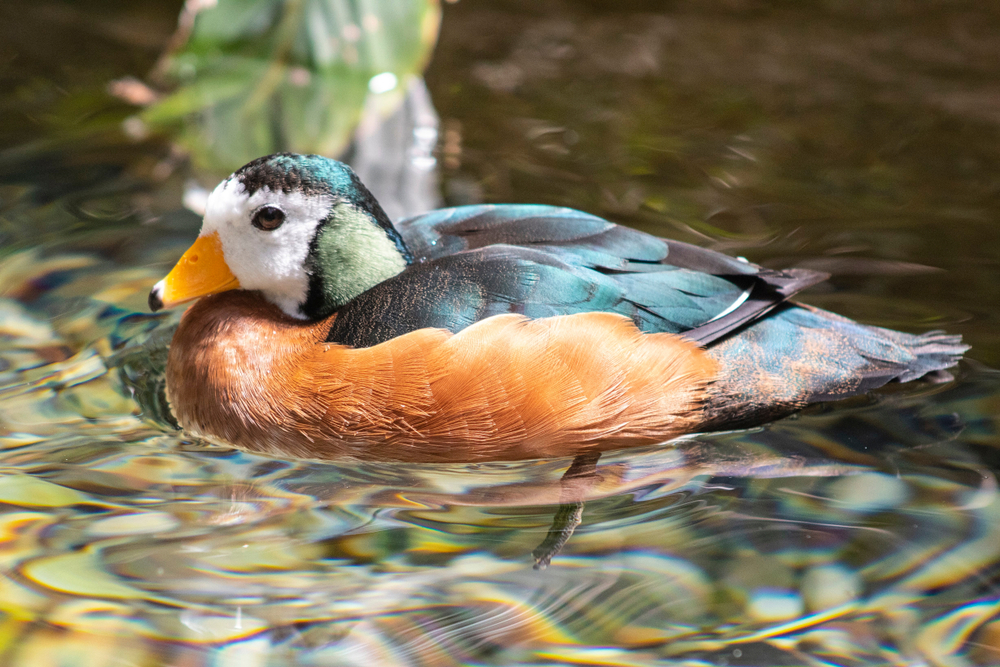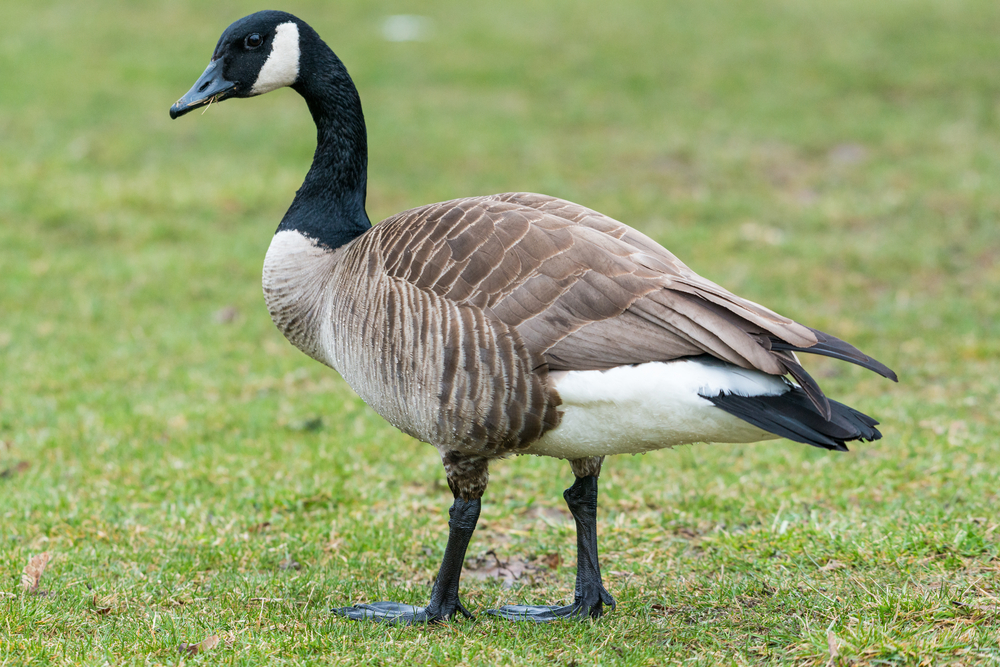Its closest relatives are other black geese in the genus Branta, especially the Canada Goose (Branta canadensis) and the Cackling Goose (Branta hutchinsii). Genetic studies also link it closely with the Brent Goose (Branta bernicla).
About
The Barnacle Goose (Branta leucopsis) is a medium-sized goose in the Anatidae family, known for its striking black-and-white plumage and remarkable migratory habits. Found across the Arctic and northern Europe, it breeds on coastal tundra in Greenland, Svalbard, and Arctic Russia, then migrates south to wintering grounds in the United Kingdom, the Netherlands, and northern Germany. Its arrival is a seasonal spectacle along Europe’s coasts and wetlands.
Barnacle Geese measure 55 to 70 centimeters (22 to 28 inches) in length, with a wingspan of 130 to 145 centimeters (51 to 57 inches). They are instantly recognizable by their black neck and breast, white face and forehead, and silvery-gray body patterned with darker bars. This bold contrast makes them one of the most visually distinctive geese.
Their diet consists mainly of grasses, sedges, and mosses during the summer breeding season, while in winter they feed on pastures, fields, and coastal saltmarsh vegetation. Barnacle Geese are efficient grazers and play an important ecological role in maintaining tundra and coastal ecosystems.
Breeding occurs on remote Arctic islands, often on cliff ledges to protect eggs and goslings from predators such as Arctic foxes. However, this forces newly hatched chicks to make a perilous leap from the cliffs to reach feeding grounds below—a dramatic survival challenge where only the strongest endure.
The species was once shrouded in myth. In medieval Europe, people believed Barnacle Geese hatched from barnacles attached to driftwood, which led to their unusual exemption from meat restrictions during fasting periods.
Today, the Barnacle Goose is listed as Least Concern, with populations increasing thanks to conservation efforts and legal protections. Its blend of beauty, legend, and resilience makes it one of the most captivating migratory geese in the Northern Hemisphere.
Physical Characteristics
The Barnacle Goose is a medium-sized, strikingly patterned goose of the genus Branta, known for its bold black-and-white contrast and compact build.
Plumage: The head is white with a distinctive black crown, throat, and neck, giving a masked appearance. The back and wings are barred with silvery-gray and black, while the breast and flanks are pale gray. The belly is whitish, and the tail is black. This crisp, contrasting plumage makes the Barnacle Goose one of the most easily recognized geese.
Head & Beak: The head is small and rounded, with a short, stubby black beak suited for grazing. The eyes are dark brown, framed by the clean white face.
Body & Wings: The body is compact and robust, with a shorter neck than many other geese. The wings are broad and pointed, allowing for strong migratory flight over long distances. Legs and feet are black, adapted for walking and grazing.
Size:
-
Length (Body and Tail): 22–28 in (55–70 cm)
-
Wingspan: 51–57 in (130–145 cm)
-
Tail Length: 4–5 in (10–13 cm)
Weight:
-
Adult Male: 4.4–6.6 lbs (2–3 kg)
-
Adult Female: 3.7–5.5 lbs (1.7–2.5 kg)
The Barnacle Goose’s bold black-and-white face, barred back, and compact body distinguish it from other geese, making it a striking sight in its Arctic breeding grounds and European wintering areas.
Reproduction
The reproductive cycle of the Barnacle Goose is highly adapted to the harsh Arctic tundra, where its breeding grounds are located.
1. Mating and Courtship:
Barnacle Geese are monogamous and form lifelong pair bonds. Courtship involves head bobbing, mutual calling, and synchronized movements. Established pairs often return to the same nesting sites year after year.
2. Breeding Season:
Breeding occurs in late May to June, soon after arrival on Arctic breeding grounds, when snow begins to melt and vegetation emerges.
3. Nesting:
Nests are built in cliffs, rocky ledges, or steep slopes, often high above the ground to protect against Arctic foxes and other predators. The nest is a shallow scrape lined with down and plant material.
4. Egg Laying and Incubation:
The female lays 3–5 creamy-white eggs. Incubation lasts about 24–25 days, performed solely by the female, while the male stands guard nearby.
5. Hatching and Chick Development:
Chicks are precocial, covered in down and able to walk within hours. Remarkably, soon after hatching, goslings leap from high cliff nests to reach the ground, guided by parents calling from below. Although many do not survive the fall, this strategy reduces predation at the nest. Parents lead the young to feeding grounds immediately after.
6. Fledging:
Goslings fledge at about 40–45 days, but remain dependent on their parents until after migration. Both parents guard and guide the young throughout the summer.
7. Sexual Maturity:
Barnacle Geese reach breeding maturity at about 3 years of age, though some may not breed until slightly later.
The Barnacle Goose’s dramatic chick leap from cliffside nests is one of the most unique and remarkable survival strategies among waterfowl, balancing the risks of falling against the dangers of predation.
Lifespan
The Barnacle Goose is a moderately long-lived migratory goose, with survival shaped by Arctic breeding challenges and long journeys between breeding and wintering grounds.
Lifespan in the Wild:
In natural conditions, Barnacle Geese typically live 12–15 years, though individuals may reach 20 years under favorable conditions. High chick mortality—especially from the perilous leaps from cliff nests and predation—reduces early survival, but adults that reach maturity often live well over a decade.
Lifespan in Captivity:
In protected settings such as wildlife reserves, aviaries, or zoos, Barnacle Geese may live up to 25–30 years, supported by consistent food and veterinary care, and free from migratory risks and predators.
Threats to the Barnacle Goose:
-
Predation: Arctic foxes, gulls, and ravens prey heavily on eggs and chicks. Goslings face high mortality during the initial cliff-leap from nests.
-
Hunting: In parts of their wintering range, they are occasionally hunted.
-
Habitat Change: Climate change alters tundra vegetation and snowmelt timing, affecting breeding success.
-
Migration Risks: Long flights across Europe expose them to storms, exhaustion, and loss of feeding grounds.
Conservation Status:
The Barnacle Goose is currently listed as a species of Least Concern by the IUCN, with stable and in some areas increasing populations, thanks to hunting regulations and protected breeding colonies.
Eating Habits
The Barnacle Goose is a grazing waterfowl with a diet primarily composed of grasses and other plant material, adapted to both Arctic breeding grounds and temperate wintering areas.
Diet:
During summer on the tundra, they feed on grasses, sedges, mosses, and shoots. In wintering areas across northern Europe, their diet shifts to pasture grasses, clover, winter wheat, barley, and other cultivated grains. They occasionally eat aquatic vegetation and roots when accessible.
Foraging Strategy:
They graze mainly on the ground, clipping grasses with their short, strong bills. In agricultural areas, they feed in open fields, often in large flocks. Their feeding is highly synchronized, with entire flocks rising and landing together to avoid predators.
Feeding Behavior:
Barnacle Geese are highly social feeders, often forming dense flocks in wintering areas. Their constant vigilance in groups reduces predation risk. They may also feed alongside other goose species such as Greylag and White-fronted Geese.
Migration and Feeding:
Energy-rich pastures and fields along migration routes are vital for building fat reserves needed for their long flights between the Arctic and Europe. Stopover wetlands and grasslands are crucial feeding sites.
Feeding Young:
Chicks feed themselves soon after hatching, grazing on tender grasses and shoots under the guidance of parents. Adults lead goslings to areas with abundant vegetation but do not directly feed them.
Seasonal Feeding:
-
Summer: Arctic grasses, sedges, mosses, and shoots.
-
Winter: Agricultural crops, clover, and grasses in Europe.
-
Migration: Pastures and meadows near key staging areas.
The Barnacle Goose’s ability to switch between wild tundra forage and agricultural crops has allowed it to maintain stable populations despite environmental pressures.
Uniqueness
The Barnacle Goose is one of the most distinctive geese of the genus Branta, remarkable for its bold appearance, unusual nesting habits, and cultural history:
Bold Black-and-White Plumage: Its striking white face and forehead, contrasted with a black crown, neck, and breast, make it one of the most recognizable geese in Europe.
Cliff-Nesting Strategy: Unlike most geese, Barnacle Geese often nest on cliff ledges and rocky outcrops in the Arctic. This unique adaptation helps protect eggs and chicks from Arctic foxes, though goslings must leap from high cliffs to reach the ground—a dramatic survival strategy.
High Chick Mortality but Strong Survivors: The cliff-jumping behavior results in heavy early losses, but survivors benefit from reduced predation at the nest and rapid access to feeding areas below.
Long-Distance Migrants: They undertake remarkable migrations, traveling thousands of miles between Arctic breeding grounds in Greenland, Svalbard, and Russia, and wintering areas in northern Europe, including the UK and the Netherlands.
Cultural Mythology: In medieval Europe, Barnacle Geese gave rise to the legend that they “hatched” from barnacles attached to driftwood, since people never saw their Arctic breeding grounds. This myth influenced dietary laws, with some believing the birds could be eaten during fasting periods as “fish.”
Conservation Success: Once declining due to hunting, Barnacle Geese have rebounded strongly in recent decades under legal protection, making them a success story among European waterfowl.
The Barnacle Goose’s unique cliff-nesting behavior, legendary folklore, and dramatic migrations make it one of the most fascinating geese in the world.
Be the First to Share Photos of This Species.
FAQ’s
1. What is the closest species to the Barnacle Goose?
2. How does the Barnacle Goose compare to other geese?
It is smaller and more compact than the Greylag Goose, with a shorter neck and striking black-and-white markings. Unlike most geese that nest on the ground, Barnacle Geese nest on cliffs, making them unique among waterfowl.
3. What national parks provide the best opportunities to see a Barnacle Goose?
What national parks provide the best opportunities to see a Barnacle Goose?
-
Svalbard Nature Reserves, Norway – Arctic breeding colonies on cliffs.
-
Greenland National Park, Greenland – Remote tundra nesting sites.
-
Wadden Sea National Park, Netherlands/Germany/Denmark – Important wintering grounds.
-
Isle of Islay reserves, Scotland – Large wintering flocks.
-
Oostvaardersplassen Nature Reserve, Netherlands – Regular wintering population.



































































